Sapphire Nitro+ Radeon RX 5700 XT review: Superfast and nearly flawless - byerlyellonly

At a Glance
Expert's Rating
Pros
- Excellent gaming carrying into action
- Trixx Boost software uses smart downscaling for great Federal Protective Service gains
- Passing cool and quiet
- Gorgeous physical design
- Thoughtful hardware and software features
Cons
- No more dedicated radiate trace hardware
- Physically large card mightiness not fit in much systems
Our Verdict
The Sapphire Nitro+ Radeon RX 5700 XT delivers first-class carrying out that's pushed even encourage with some smart software tricks, and the graphics card's ironware innovation is so thoughtful it's virtually flawless. We canful't think of anything we'd exchange.
Best Prices Today

$1,249.00
Free
It's been a long clock coming, but the custom Radeon RX 5700 Crosstalk series nontextual matter cards are finally starting to flow. Today we're taking a flavour at the $440 Sapphire Nitro+ Radeon RX 5700 XT, well-stacked around the more powerful version of AMD's two "Navi" GPUs and Sapphire's flagship Nitro+ custom design.
The wait for these pieces of heavier-obligation customs kit was worth IT. Just last week, we reviewed XFX's rival Radeon RX 5700 XT Thicc Two Ultra, falling soft on with its gorgeous design, evoking classic muscle cars. Like a on-key hot-rod, it was beautiful and fast, but besides ran a trifle loud and needful some tinkering for peak public presentation. Information technology was slightly imperfect but wholly impressive.
The Sapphire Nitro+ Radeon RX 5700 XT is nearly flawless. It's hard to image a more complete partizan-sort custom design than this. And with the help of some ingenious software tricks, Sky-blue can even catapult the Nitro+'s public presentation into a unscathed otherwise class, putting it squared-toe-to-toe with Nvidia's fearsome GeForce RTX 2080 Super and RTX 2080 Ti for hundreds of dollars less. Let's go!
Sapphire Nitro+ Radeon RX 5700 XT: Spectacles, price, and features
Sapphire's graphics card puts an overclocked, highly customized birl happening AMD's Radeon RX 5700 XT's "Navi" GPU, and then pushes even further with just about clever software tricks and optional upgrades.
This coevals's Navi chips are chock full of cutting-adjoin features: They're the forward consumer GPUs made-up victimization the 7nm manufacturing process, the first GPUs to support the ultra-fast PCI 4.0 interface (if you pair it with a Ryzen 3000 CPU and an X570 motherboard), and the first GPUs created with AMD's spick-and-span underlying "RDNA" graphics architecture. The combination of RDNA and 7nm greatly improved the power efficiency of Radeon GPUs, and the RX 5700 serial publication performs much wagerer in games that accustomed strongly favor Nvidia's GeForce graphics card game. AMD also introduced helpful software tricks like Radeon Image Sharpening to help get bettor performance out of your hardware—which Sapphire leverages to important effect with its Trixx Encourage package—though Navi does non support real-time ray tracing like the GeForce RTX 20-series.
This review focuses on the Sapphire Nitro+ Radeon RX 5700 XT's bespoken tweaks and overall performance. Here's a look at the stock specifications for the Radeon RX 5700 series compared to last contemporaries's Radeon Lope Felix de Vega Carpio GPUs to get you up to hurrying:
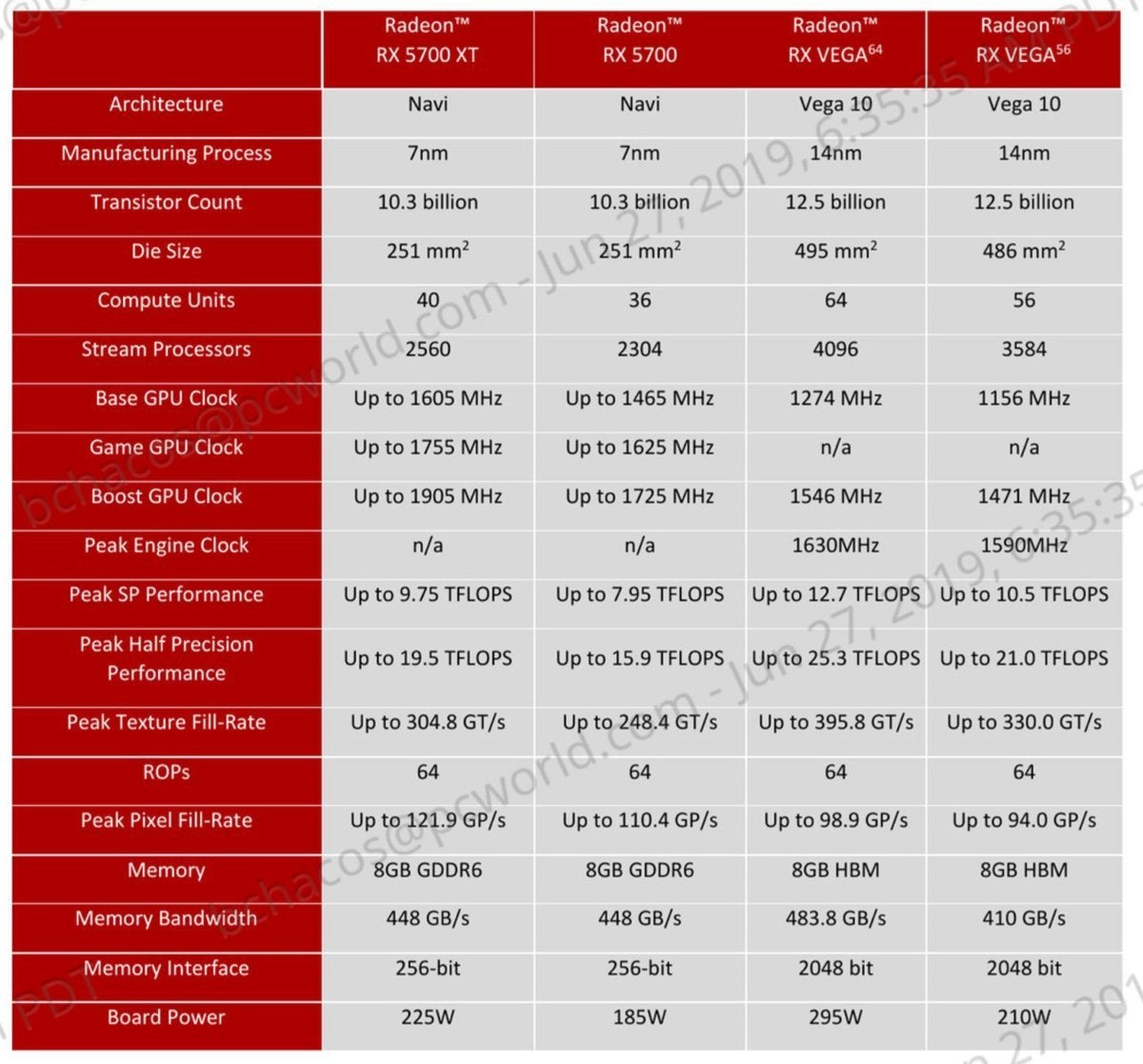 AMD
AMD And present's a spirit at the Sapphire Nitro+'s ain specifications:
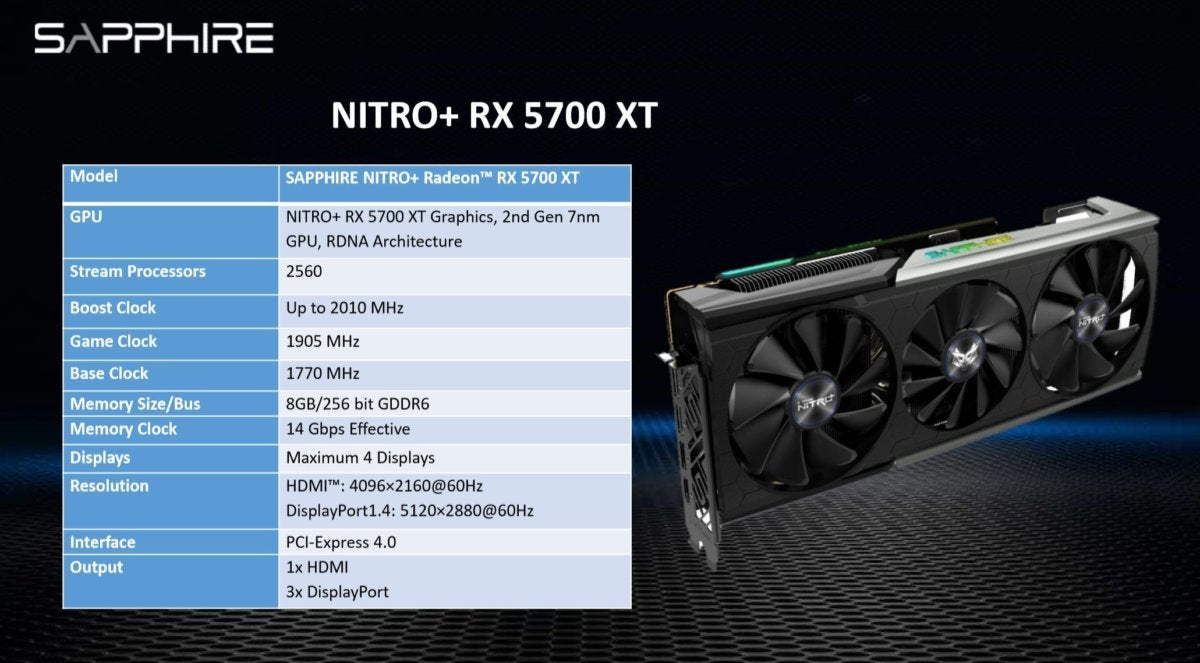 Lazuline
Lazuline When it comes to rear-of-the-box stats, the Sapphire Nitro+'s biggest change comes in clock speeds, providing a large jump in raw frequencies. The Nitro+'s base clock speed is faster than the reference RX 5700 XT's Gamy time speed, which is the hoped-for minimum time speed up you can expect to look in gaming workloads. The Nitro+'s rated Game clock lands north of 1,900MHz, and in practice, we saw it boosting even higher in games. This thing is fast—and the company's innovative "Trixx Boost" software characteristic can advertize information technology to blazing new high if you're willing to take in a tiny resolution drop. More on that after our gaming benchmarks later.
Coaxing so much performance out of AMD's "Navi" GPUs isn't easy. Sapphire bumped the power connectors from the reference card's 6-pin and 8-pin configuration to two 8-pin connectors, and outfitted the Nitro+ with the company's highest-end custom cooling system solution, dubbed Tri-X.
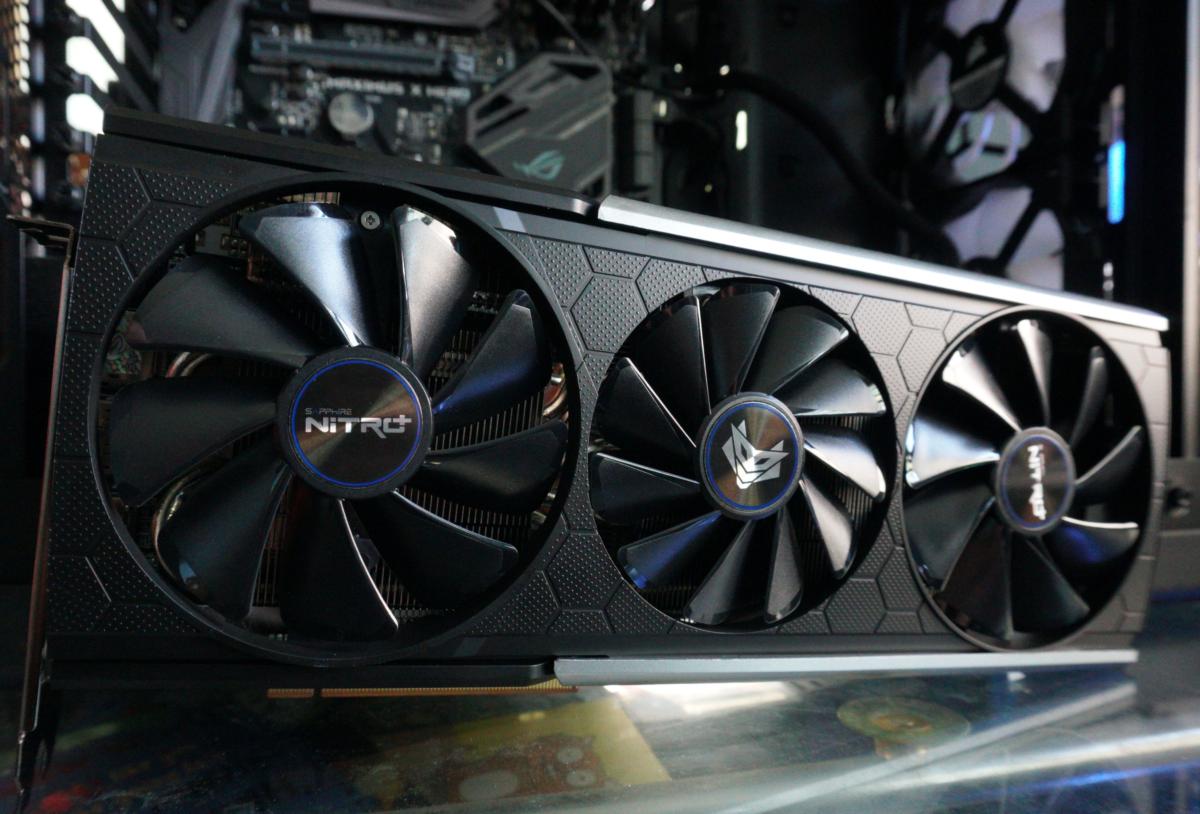 Brad Chacos/IDG
Brad Chacos/IDG Tri-X embeds a trio of fans in the card's sleek silver and black aluminum cerement. The two larger outmost fans rotate normally, while the small wrong fan spins in the opposite direction "to encouragement wind flow beneath the fans." Sapphire claims that arrangement, paired with the tunneled breaking ball of the fans themselves, increases "the convection of airflow to ensure that Tri-X chilling is a low temperature and low noise cooling solution." In our tests, the claim proved true, as the Nitro+ runs far chillier than the citation design and stays quiet under load, with fan speeds never top-flight 1,800rpm. For comparison, the XFX Thicc II Ultra's more audible fans spin at 2,100rpm to 2,300rpm.
Newfangled for the Radeon RX 5700 serial publication Nitro+ models, Sapphire like a sho offers upgradeable ARGB fans, augmenting the fan health monitoring and "Nitro Glow" RGB control features it's been building in the company's Trixx Software. The upgrade kit out costs $30 and includes a pair of 95mm fans and a smaller 87mm inside winnow. Every you need to brawl unscrew the alive fans, then slip in the inexperient ones.
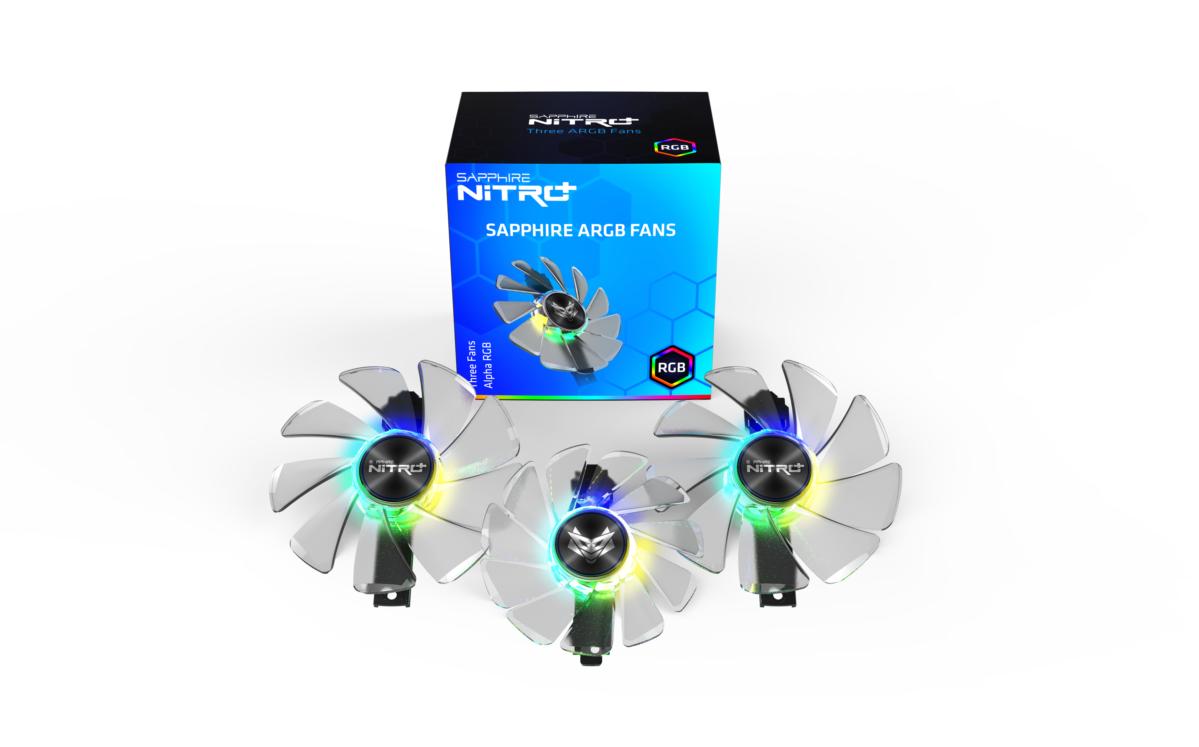 Sapphire
Sapphire Sapphire's optional ARGB fan upgrade kit for the Nitro+ Radeon RX 5700 Crosstalk.
Customizable ignition is a big focus for the Nitro+. You'll find the standard RGB LEDs embedded in the Cerulean logo on the side of the card, but Sapphire also added a slew of RGB lights to the edge in and in the logo on the metallic backplate of the card, which incandescence in a stunning shifting rainbow formula by nonpayment. If you'd prefer to synchronize the RGB lighting with your motherboard's, Sapphire added an addressable 3-peg header in the tail of the poster. After plugging IT into a RGB header on your motherboard you force out select to have your motherboard software control the graphics card's RGBs interior of Trixx.
Premium touches like this are what set the Nitro+ railway line apart from Cerulean's more budget-oriented GPUs like the brilliant Pulse Radeon RX 5700.
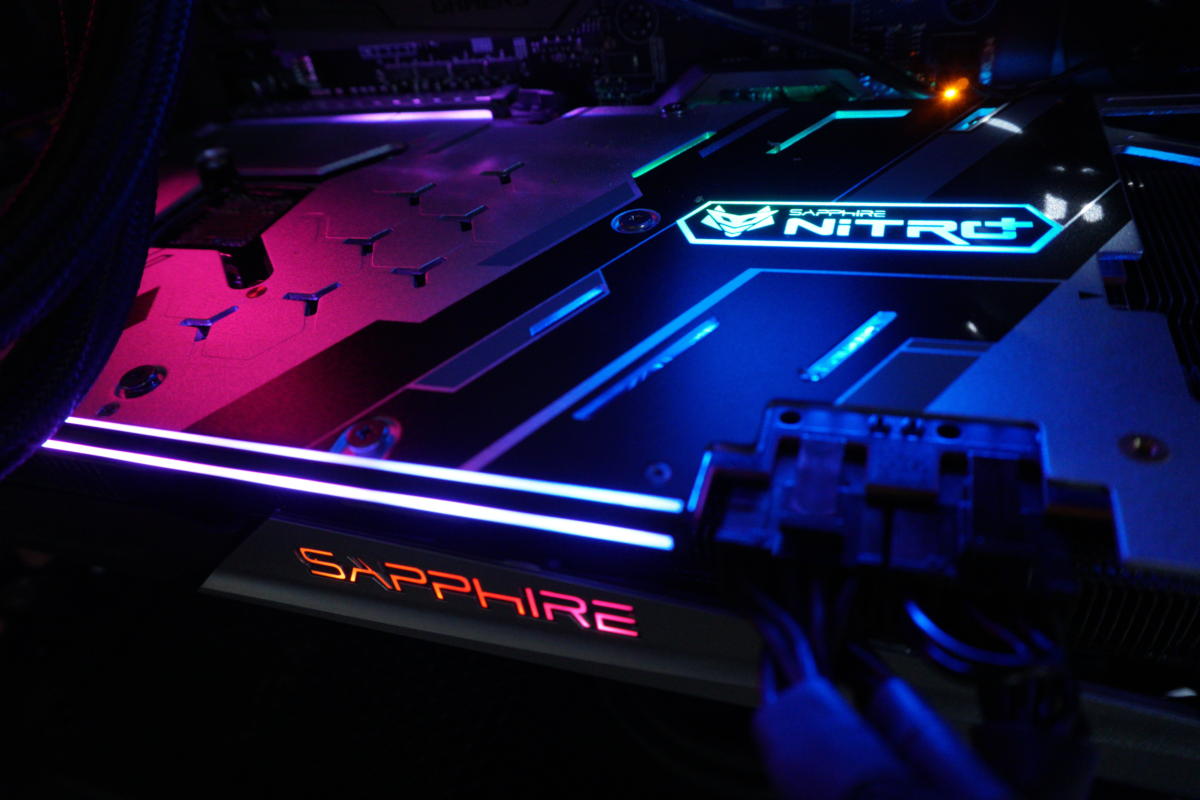 Brad Chacos/IDG
Brad Chacos/IDG Sapphire's design isn't all flash, though. This is a foot-long artwork card, thanks to a massive full-length heatsink augmented by four full-length heat pipes underneath the facile cerement. To a greater extent than full-length, actually, as the cinque stack extends on the far side the Nitro+'s PCB and backplate. Sapphire promote beefed outer the card with holy VRM and memory cooling, meld protection, cooler and Thomas More power-businesslike black diamond chokes, and 7+1+2-stage digital power delivery for wagerer potential overclocking carrying into action. The Nitro+ comes to the full loaded.
Another discriminate touch: Sapphire goes beyond the dual-BIOS switch that's somewhat common among higher-end custom cards, adding a third background. The first two do what you'd carry, shifting 'tween the default superior mode and a secondary profile that sacrifices some speed for bring dow acoustics. But the third is stimulating: IT allows you to control which of those deuce BIOS profiles you'atomic number 75 using within Sky-blue's Trixx software, negating the need to prize open your case's side panel and manually pass a electrical switch.
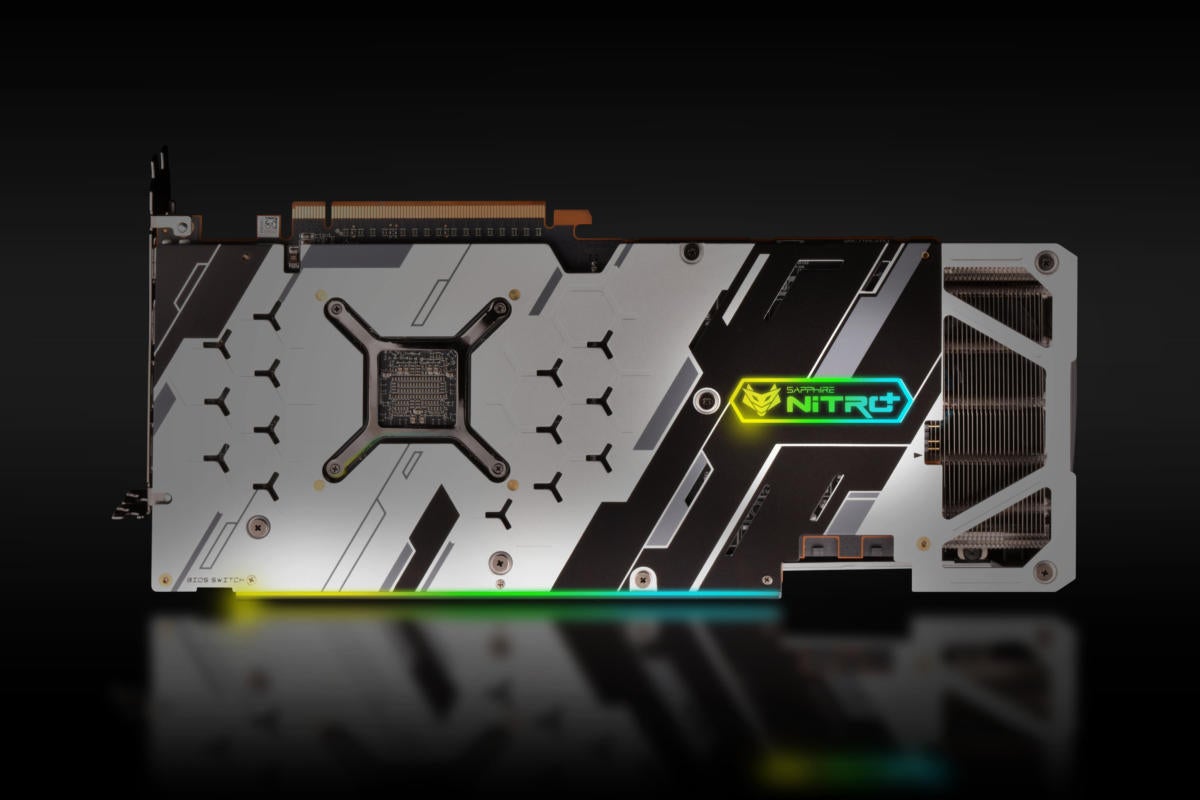 Cerulean
Cerulean Dolabriform? Convinced. But I love to see quality-of-life improvements like this, and information technology emphasizes how more unnecessary utility Azure managed to squeeze intro Trixx for this new Radeon propagation—spearheaded aside the performance-enhancing Trixx Boost feature. Let's acquire this to the examination bench!
Following pageboy: Our trial system, gaming benchmarks begin
Our test scheme
Our devoted graphics card try system is jam-packed with whatever of the fastest complementary components available, to put any potential performance bottlenecks squarely on the GPU. Most of the computer hardware was provided aside the manufacturers, but we purchased the ice chest and storage ourselves.
- Intel Core i7-8700K processor ($350 on Amazon)
- EVGA CLC 240 closed-loop musical cooler ($120 on Amazon)
- Asus Maximus X Hero motherboard ($395 on Amazon)
- 64GB HyperX Predator RGB DDR4/2933 ($420 connected Amazon)
- EVGA 1200W SuperNova P2 superpowe supply ($230 on Amazon)
- Corsair Crystal 570X RGB case, with front and top panels removed and an extra rear fan installed for improved flow of air ($130 on Amazon)
- 2x 500GB Samsung 860 EVO SSDs ($78 each on Amazon River)
We're comparing the $440 Sapphire Nitro+ Radeon RX 5700 XT against the similarly priced $440 XFX Radeon RX 5700 XT Thicc II Extremist. We're also roughness it against AMD's $350 reference point Radeon RX 5700, the $400 book of fact Radeon RX 5700 Crosstalk, the $400 GeForce RTX 2060 Super Founders Edition, and the $500 GeForce RTX 2070 Super Edition. Its nighest competitors, basically. For a broader front at how AMD's inwardness GPU stacks up against other cards, be indisputable to baulk out our original Radeon RX 5700 series follow-up.
Every card was proven with their nonpayment BIOS if tenfold BIOS options were for sale. Some the Nitro+ and XFX's Thicc Deuce Ultra default to high performance over lower acoustics.
All prices cited are launch MSRP. You can oftentimes ascertain reference RX 5700 cards cheaper happening the streets these days, piece bespoke RTX Super GPUs tend to sell for more than the (now-gone) Founders Edition cards.
Each game is tested victimization its in-game benchmark at the highest possible graphics presets, with VSync, frame rate caps, and all GPU vendor-specific technologies—like AMD TressFX, Nvidia GameWorks options, and FreeSync/G-Sync—injured, and lineament anti-aliasing (TAA) enabled to push these high-end cards to their limits. If anything differs from that, we'll mention it. We run each benchmark at least three multiplication and list the medium result for each test.
Because the Sapphire Nitro+ is a faster Radeon RX 5700 Crosstalk at its core, we're going to skip our usual commentary after each gaming benchmark and let the testing speak for itself. We'll provide more psychoanalysis during the thermal and noise results and put a bend on things in our closing recommendations.
Gaming performance benchmarks
Division 2
Let's start with the up-to-the-minute games. The Division 2 is one of the best looter-shooters of all time created. The luscious visuals generated by Ubisoft's Wood anemone engine arrive even easier to incur lost in post-apocalyptic Washington D.C. The intrinsic bench mark cycles through tetrad "zones" to run an array of environments. We examine with the DirectX 12 renderer enabled. IT provides better performance across the board than the DX11 renderer, merely it requires Windows 10.
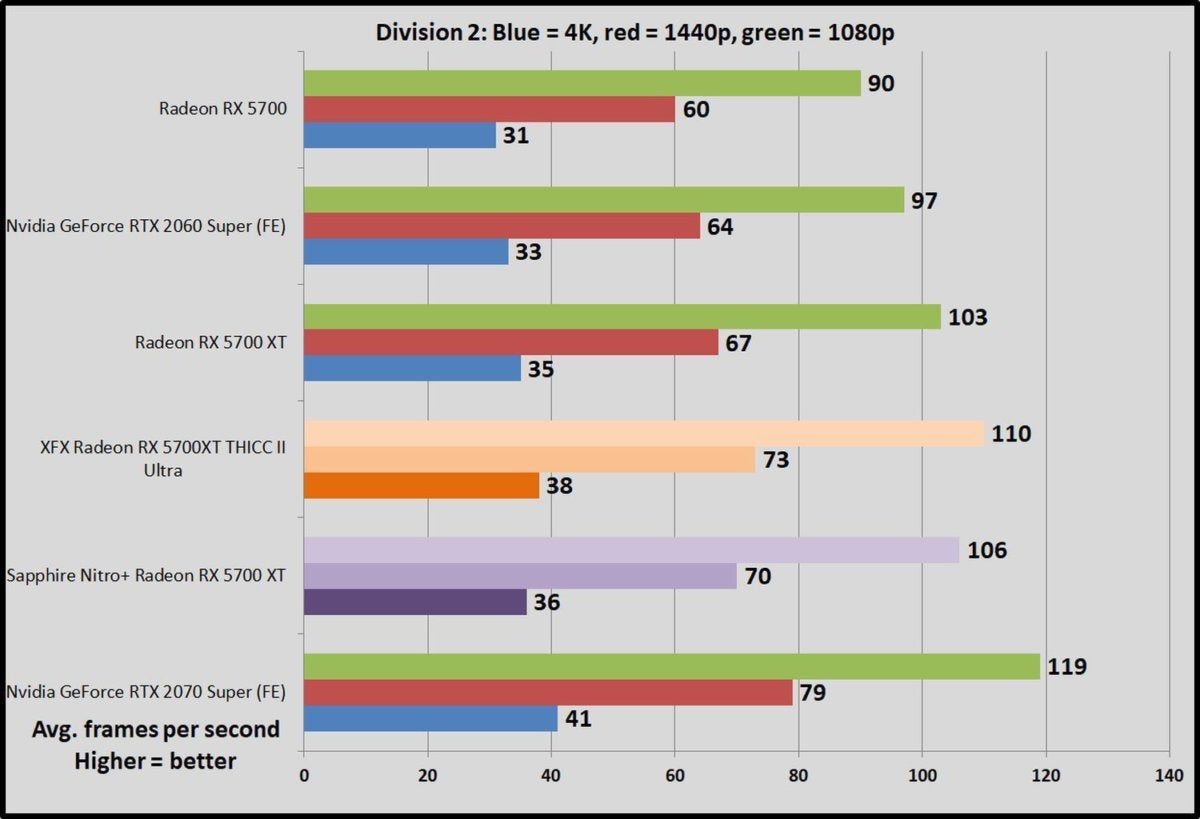 Brad Chacos/IDG
Brad Chacos/IDG Interahamw Cry: Unused Dawn
Another Ubisoft title, Far Cry: New Fall into place drags Far Outcry 5's wonderful gameplay into a post-calamity future of its own, though this vision is a lot more bombastic—and rap—than The Division 2's hopeless mount. The game runs on the latest version of the long-running Dunia engine, and it's slightly more strenuous than Furthest Cry 5's made-up-in bench mark.
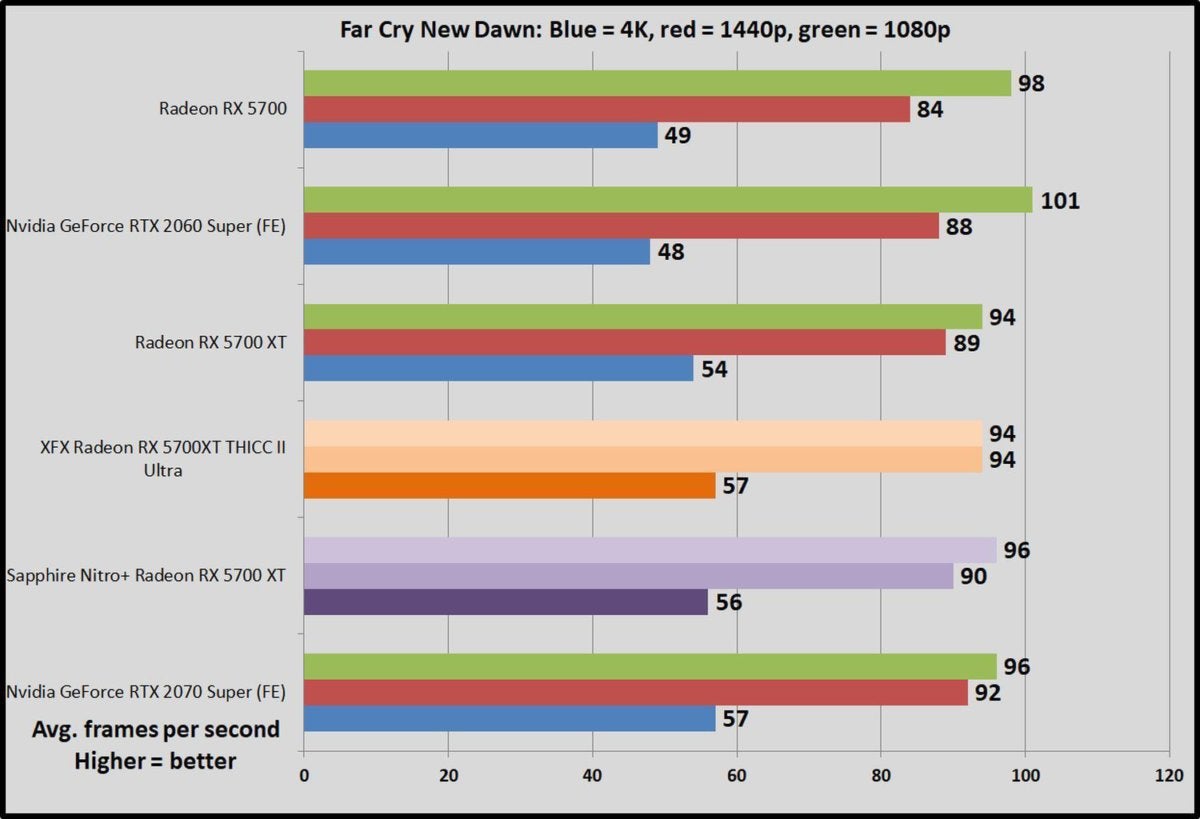 Brad Chacos/IDG
Brad Chacos/IDG Strange Brigade
Strange Brigade ($50 connected Humble) is a cooperative one-third-person shooter where a team of adventurers blasts through hordes of mythological enemies. It's a technical showcase, built around the next-gen Vulkan and DirectX 12 technologies and infused with features like HDR support and the ability to toggle asynchronous compute connected and off. It uses Rebellion's custom Azure engine. We test the DX12 renderer with async compute off.
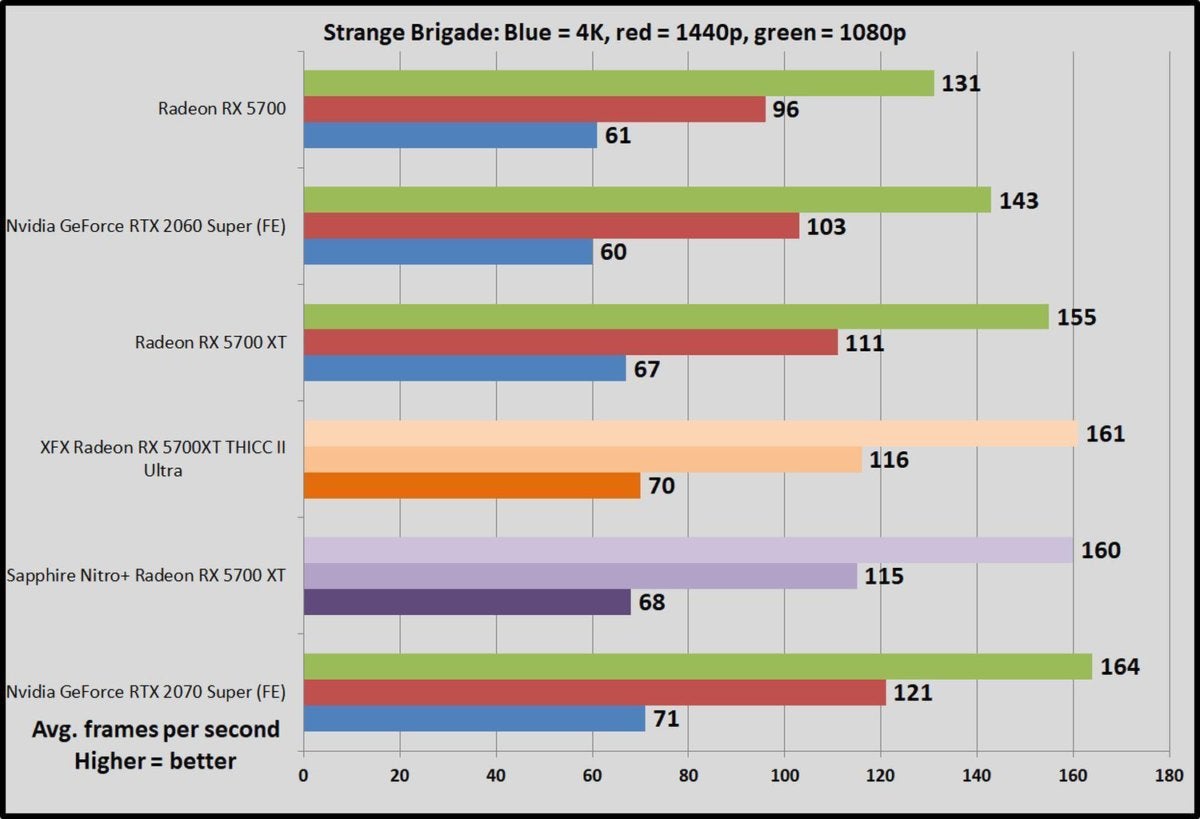 Brad Chacos/IDG
Brad Chacos/IDG Next page: Gaming benchmarks continue
Shadow of the Grave Raider
Vestige of the Grave Raider ($60 on Chagrin) concludes the reboot trilogy, and it's absolutelygorgeous. Square Enix optimized this game for DX12, and recommends DX11 single if you'Re victimisation older hardware or Windows 7, so we screen with that.Shadow of the Tomb Raider uses an enhanced version of the Foundation engine that as wel poweredRise of the Tomb Raider.
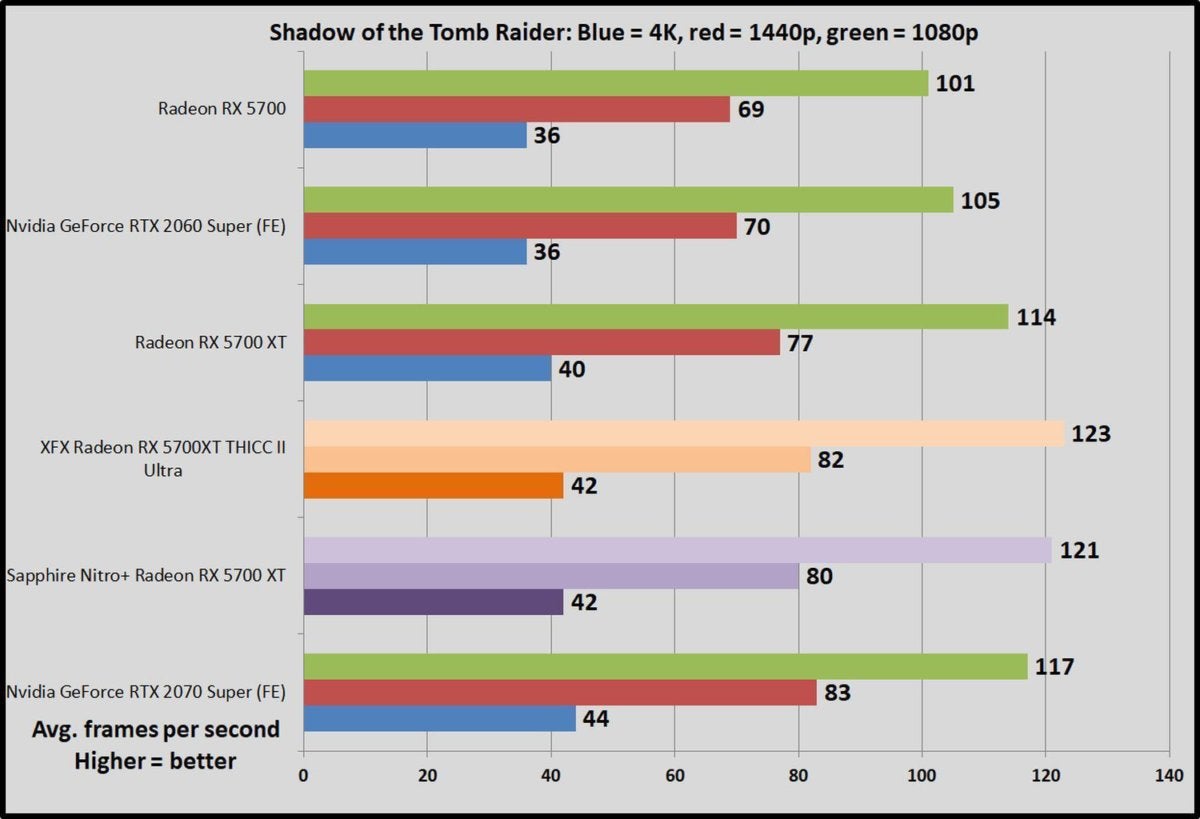 Brad Chacos/IDG
Brad Chacos/IDG Ghost Recon Wildlands
Give way,Crysis. If you crosspatch all the graphics options upbound to 11, like we practice for these tests,Ghost Recon Wildlands($50 on Humble) and its AnvilNext 2.0 engine absolutelymelt GPUs, true with a subsequence due subsequently this year. It's by utmost the most straining game in our suite, even with newer stunners care Division 2 in the mix. We'll probably trade this out with Ghost Recon Breakpoint when it launches later this year.
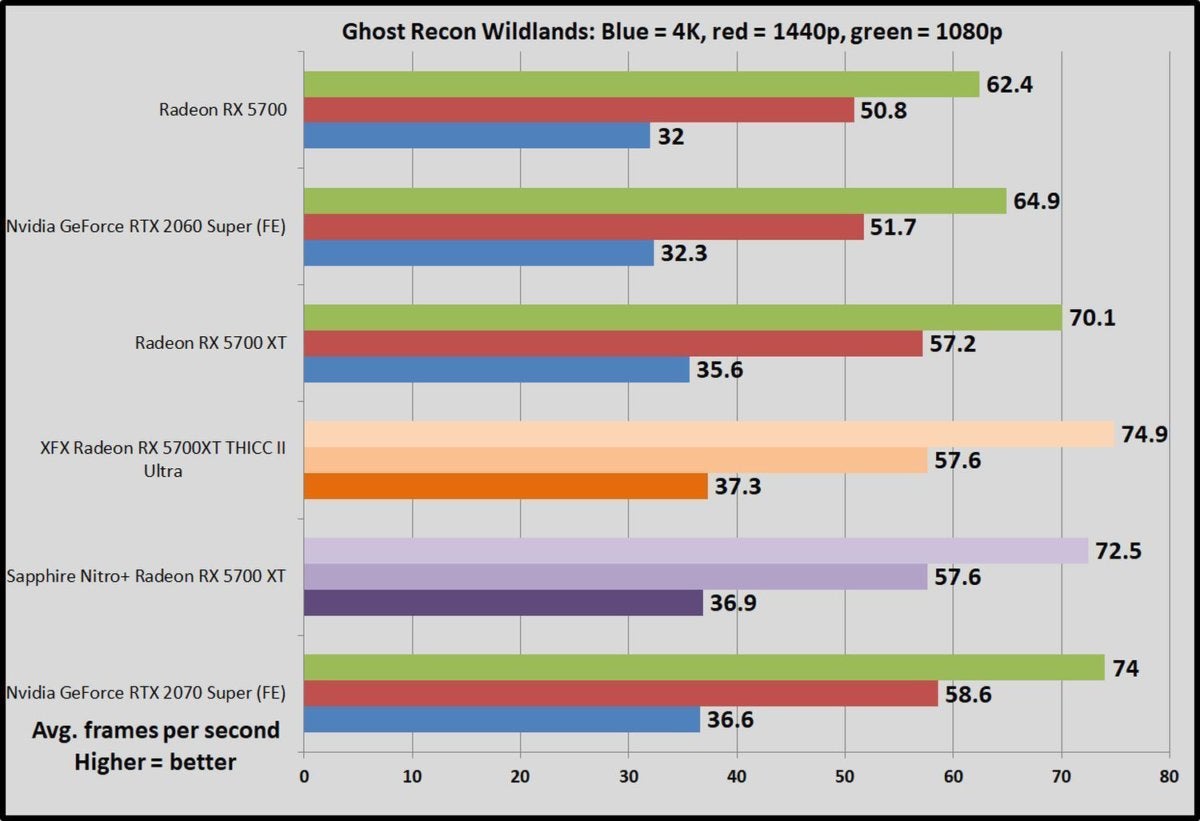 Brad Chacos/IDG
Brad Chacos/IDG F1 2018
The latest in a long line of successful games,F1 2018($60 on Humble) is a gem to test, supplying a wide array of some graphical and benchmarking options—making information technology a much Sir Thomas More reliable (and fun) option that theForzaseries. It's built on the fourth version of Codemasters' soapy-smooth Ego lame locomotive engine. We test 2 laps on the Australia course, with clear skies.
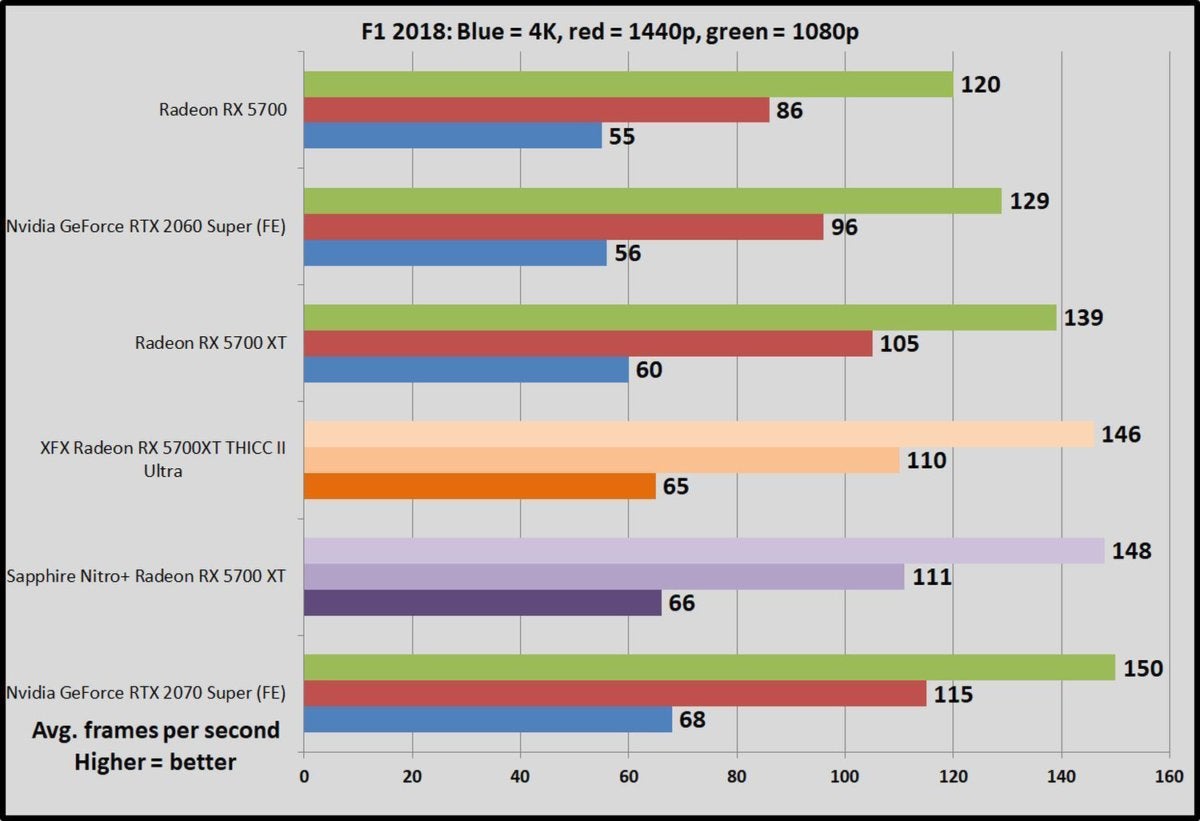 Brad Chacos/IDG
Brad Chacos/IDG GTA V
We're going to wrap things up with a game that isn't really a visual barn-burner, but still tops the Steam charts day in and day retired. We testGrand larceny Auto V ($30 happening Humble) with all options turned to Really High, all Advanced Graphics options except extended shadows enabled, and FXAA.GTA Vruns on the RAGE engine and has received substantial updates since its initial launch.
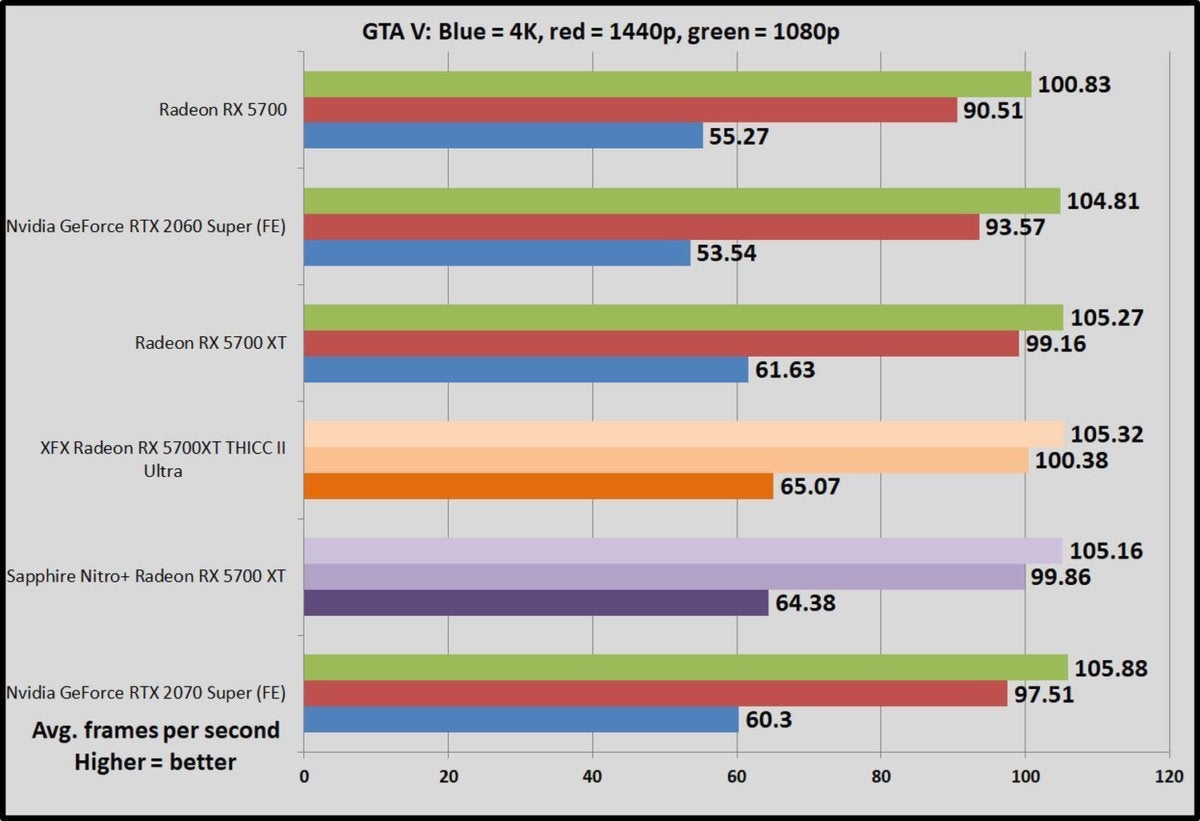 Brad Chacos/IDG
Brad Chacos/IDG Next page: Trixx Boost's haywire functioning enhancements
Trixx Boost: Slightly lower result, much quicker performance
Sapphire is rolling out a greatly enhanced version of its Trixx overclocking and monitoring software system to accompany the Nitro+'s launch, revolving some an awesome new feature dubbed "Trixx Boost." As I said when I tested a trailer interlingual rendition for the Sapphire Pulse Radeon RX 5700 critique, Trixx Boost is wonderful, broad block up.
Sapphire provided a beta version for Nitro+ reviewers to test, but you don't have to take my word on how information technology performs. The early version of Trixx is getable now. Most of the following schoolbook is pulled from my earlier preview, as IT still behaves the same.
Trixx Boost essentially creates bespoke, configurable new display resolutions that you can select in-spunky, slightly less pixel-packed than the most common gambling resolutions: 4K, 1440p, and 1080p. The small inclination in overall firmness of purpose greatly enhances gaming frame rates. Sapphire's instrument allows you to actuate AMD's brilliant new Radeon Image Sharpening technology to restore what little visual fidelity is forgotten at virtually no performance impact. The final image is just about indistinguishable from rendering at native resolution, but it runs at much higher speeds.
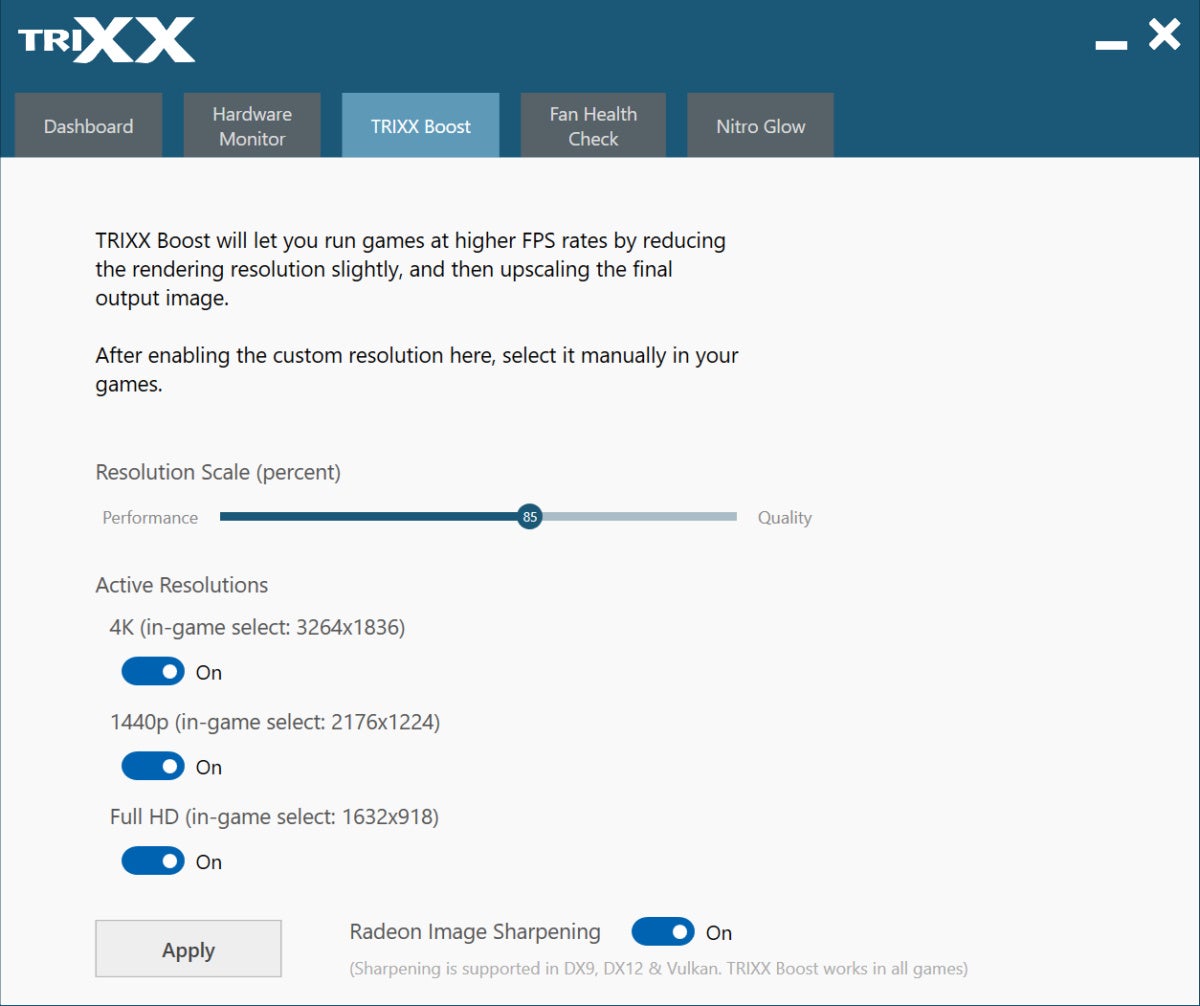 Brad Chacos/IDG
Brad Chacos/IDG Sapphire says Trixx Boost should work with older GPUs as well, and AMD recently added Radeon Image Sharpening support to the Radeon RX 470, 480, 570, 580, and 590. However, RIS works only in DX9, DX12, and Vulkan games. Vrucially, DX11 (a.k.a. the almost commonly used game renderer) ISN't supported however, and you can't use it in DX9 games for non-Navi GPUs.
Each that aforementioned, testing Trixx Encourage inFar Cry: Novel Dawn, a DX11 bet on, shows next to no seeable impact. Cost increase is the real star here, and works in all games. RIS is just the cherry on top when IT's available.
Entering the Boost tab key of Trixx reveals the tool's straightforward settings. You practice a slider to determine at what percentage of the original resolution you want the Cost increase resolutions created. Aside default option, information technology was set to 85 percent, which I used for testing. You and so decide which familiar gaming resolutions bequeath get Hike variants. You could create exactly one for your virtually-ill-used resolution or enable the whole 4K/1440p/1080p plenty—and choose whether to enable Radeon Prototype Sharpening. Once you're done, clickApply. Your block out will shoot and flicker for a few seconds while the Pulse GPU creates the new resolutions.
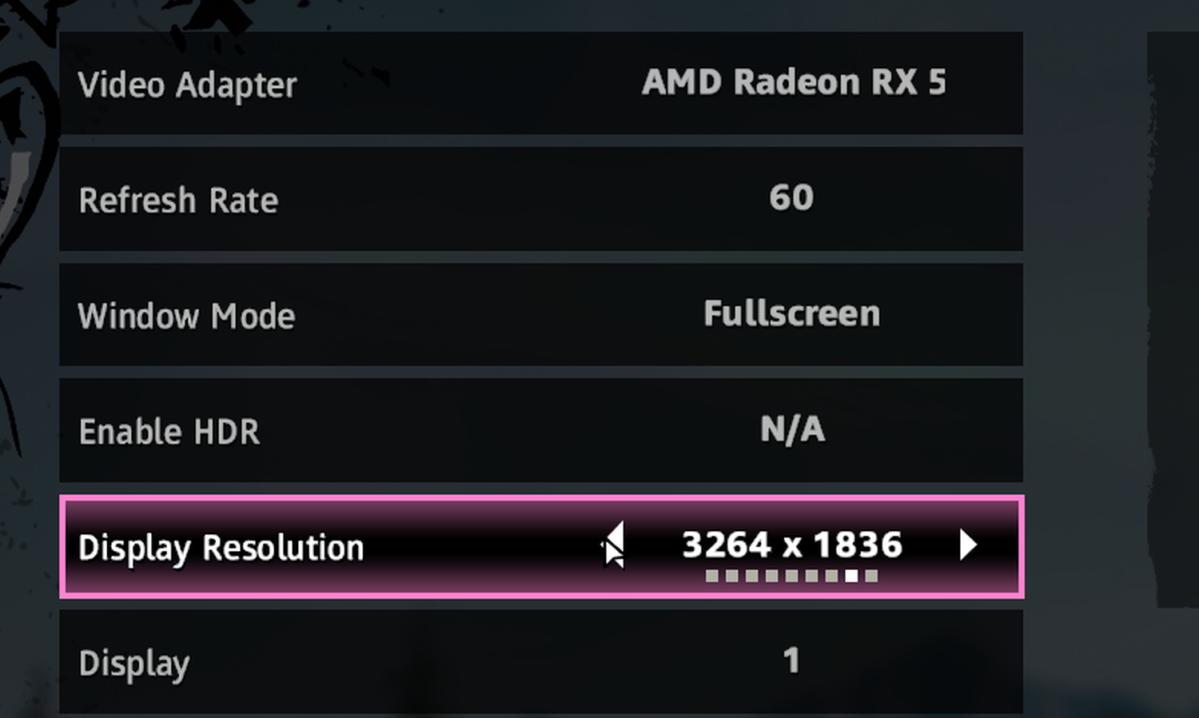 Brad Chacos/IDG
Brad Chacos/IDG Screenshot of a custom resolution created using Sapphire's Trixx Boost software.
Totally that's left to do subsequently that is to choice the new Boost resolution manually in your games. A you can see in the image above, with Trixx Boost set to 85 percent, it created a display resolution of 3264×1836 to use as an alternative to the standard 3840×2160 "4K" solving. Both the standard resolutions as well as the Boost resolutions appear as options, indeed be sure to prize the correct one to get Boost's advantages.
What an advantage it is. Here are the performance results running the following games at standard 1440p and 4K resolutions, and at the Boost-created 2304×1296 and 3264×1836 resolutions. Just look at the results!
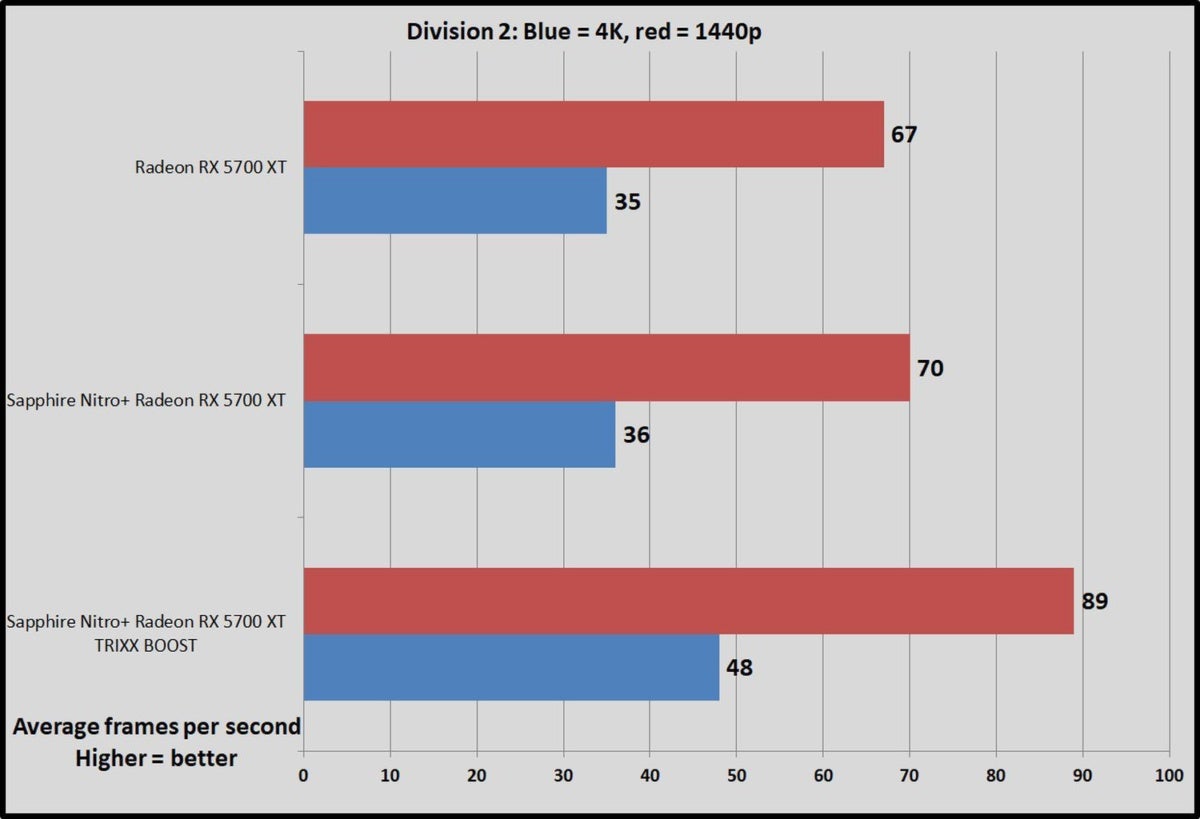 Brad Chacos/IDG
Brad Chacos/IDG 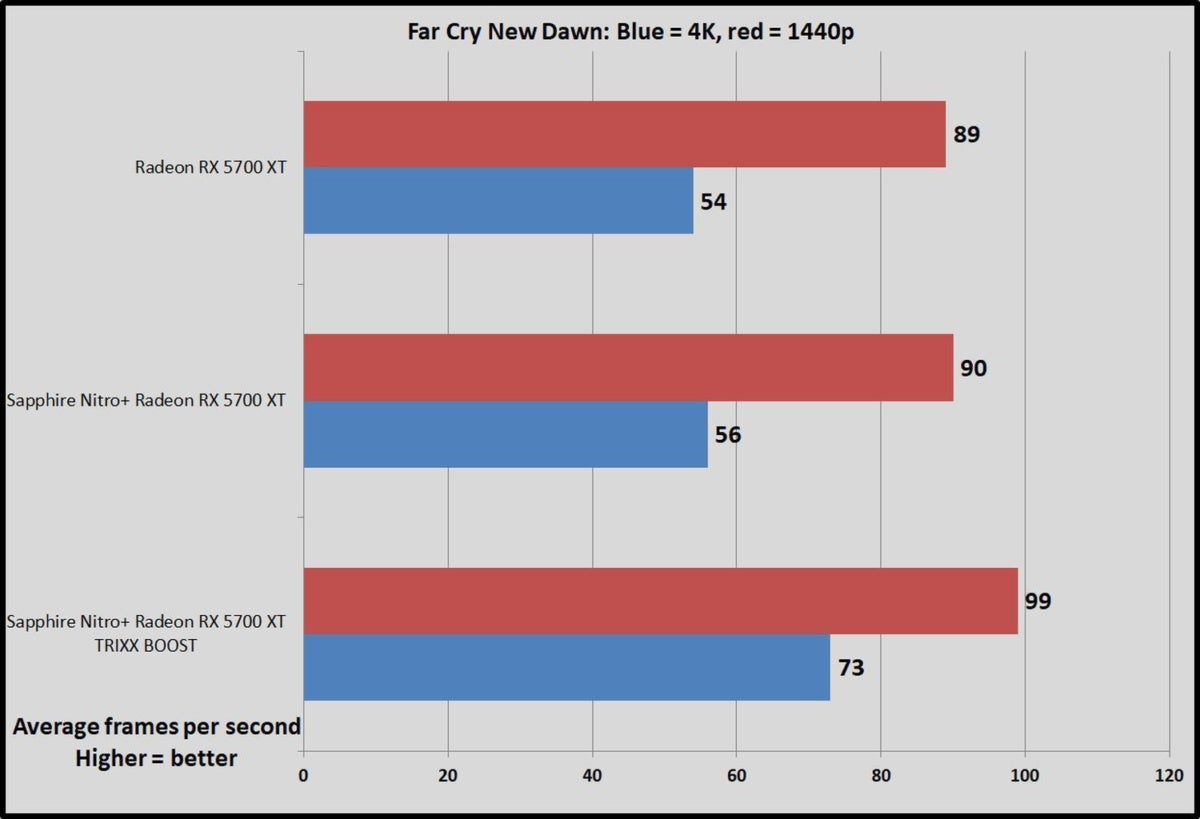 Brad Chacos/IDG
Brad Chacos/IDG 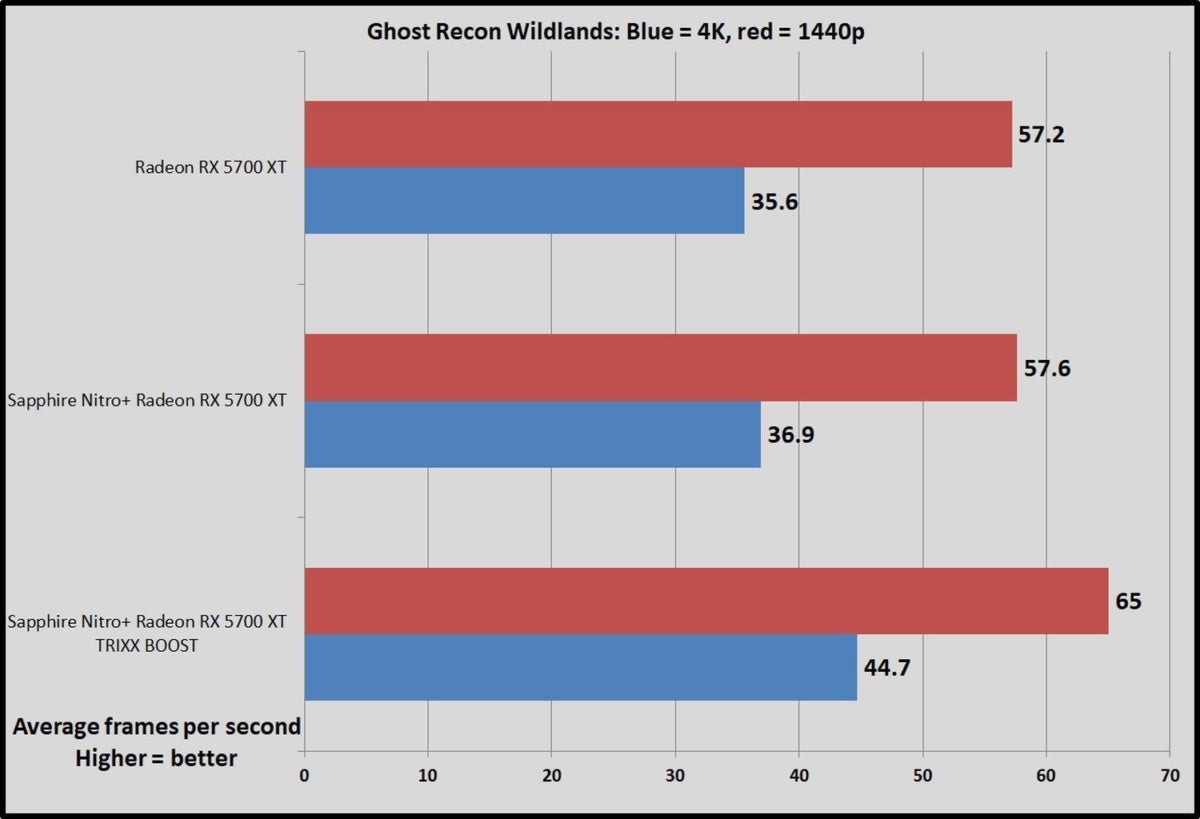 Brad Chacos/IDG
Brad Chacos/IDG With Trixx Rise active, the $440 Sapphire Nitro+ Radeon RX 5700 XT hits the aforementioned frame rates as the $700 GeForce RTX 2080 Tops Founders Edition at 1440p resolution. At 4K, the Nitro+ surpasses it, coming damned near the performance of the monstrous $1,200 GeForce RTX 2080 Ti in Ghost Recon Wildlands and Far Cry New Morning. (It ties the RTX 2080 Super in Division 2 at 4K.) You could presumptively get-up-and-go performance even further if you spent five transactions in AMD's Radeon Settings app using Wattman's one-click auto-overclocking tools.
Holy. Crap. If you buy the Chromatic Nitro+, go download Trixx and activate Trixx Hike pronto.
These tricks aren't unique, to be light up. You can create custom resolutions for the same effect victimization other software system options. But few populate external of enthusiasts ever pain with those ecological niche hardcore tools. Trixx Boost makes it so quick, well-off, and painless to achieve noticeably faster speeds with minimal visual impact, it's a pleasure. This is a big feather in Chromatic's capital.
That's not to say Trixx Encouragement is perfect. I'd like to see to it widescreen resolution options rolled in as well, and for Chromatic to integrate Radeon Wattman's one-click auto-overclocking for a noob-friendly performance advance. (The software supports overclocking, but alone in manual form, which requires much run-and-computer error and time.) Merely this is a stellar opening, a smart spin on the industry's newfound infatuation with upscaling for more performance. I suspect else GPU makers may find "inspiration" from Trixx Boost soon.
Next page: Power, thermals, and noise
Power standoff, thermals, and noise
We also dependable the Sky-blue Nitro+ Radeon RX 5700 XT using 3DMark's highly illustrious Fire Strike synthetic benchmark. Can Strike runs at 1080p, Fire Strike Intense runs at 1440p, and Fire Bang Extremist runs at 4K resolution. All render the Lapplander fit, simply with more than intense graphical effects as you move awake the scale, so that Extreme and Ultra flavors stress GPUs even more. We show the graphics score to eliminate variance from the CPU.
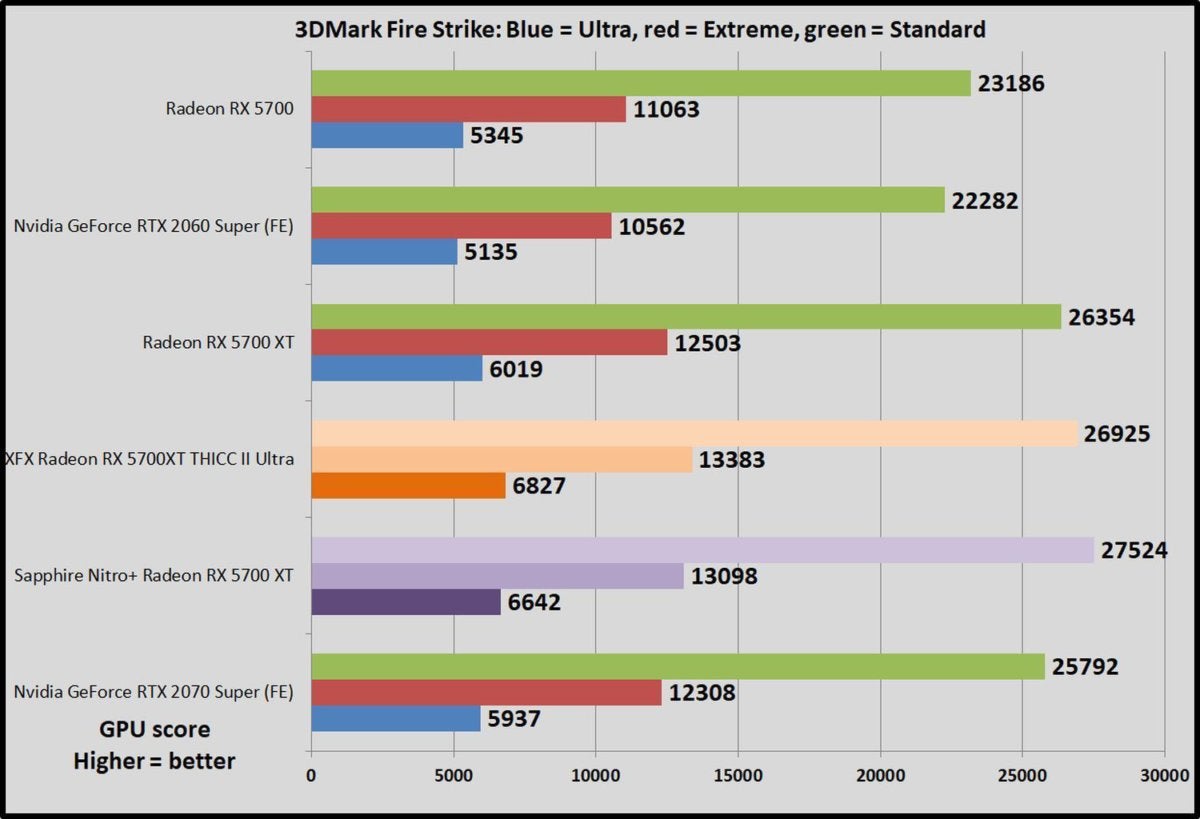 Brad Chacos/IDG
Brad Chacos/IDG Fire Strike performance doesn't seem to correlate with really-worldwide games performance very powerfully anymore, every bit these results would put it roughly in short letter with the much more than powerful $700 GeForce RTX 2080 Super—which IT emphatically isn't. We'll probably switch to another synthetic benchmark before long.
We psychometric test power draw by iteration theF1 2018 bench mark for about 20 minutes later we've benchmarked everything other and noting the highest reading on our Watts Heavenward Pro meter. The initial part of the race, where all competing cars are onscreen simultaneously, tends to be the most demanding portion.
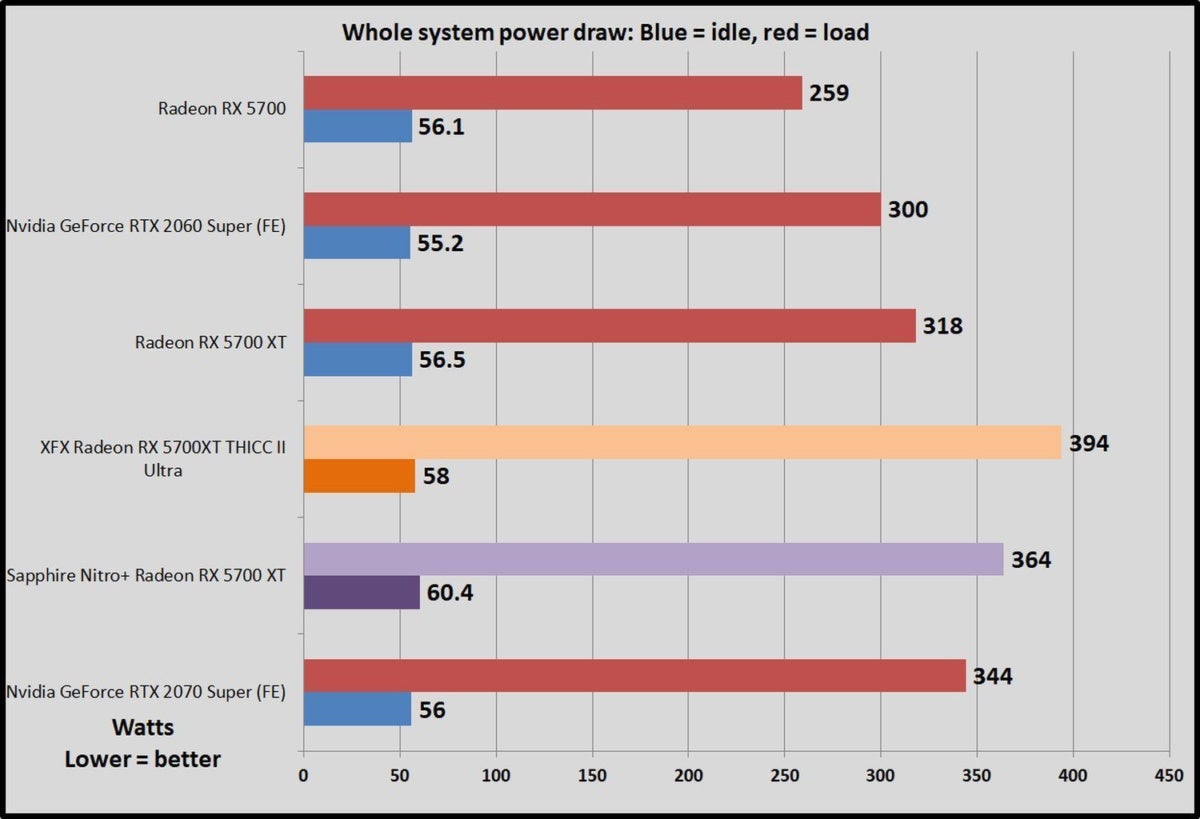 Brad Chacos/IDG
Brad Chacos/IDG The overclocked, triple-devotee, RGB illuminated Sapphire Nitro+ draws more tycoo than the reference Radeon RX 5700 XT, as you'd expect. But AMD's new Navi GPUs are significantly more power efficient than previous Radeon chips, and they're now competitive with Nvidia's vaunted index efficiency. Comparing the Nitro+ with the slightly higher clocked XFX Thicc II Extremist shows how hard it is to squeeze more performance out of Navi, though. The XFX is barely quicker than the Nitro+ in games—just a few frames here and there—but the Thicc II Ultra sucks down a lot more than great power despite having incomparable less fan and no RGB firing some.
We quiz thermals aside departure either AMD's Wattman (for Radeon GPUs) or EVGA's Precision X1 (for GeForce GPUs) open during theF1 2018 five-lap power hook mental testing, noting the highest maximum temperature (in Celsius) at the end.
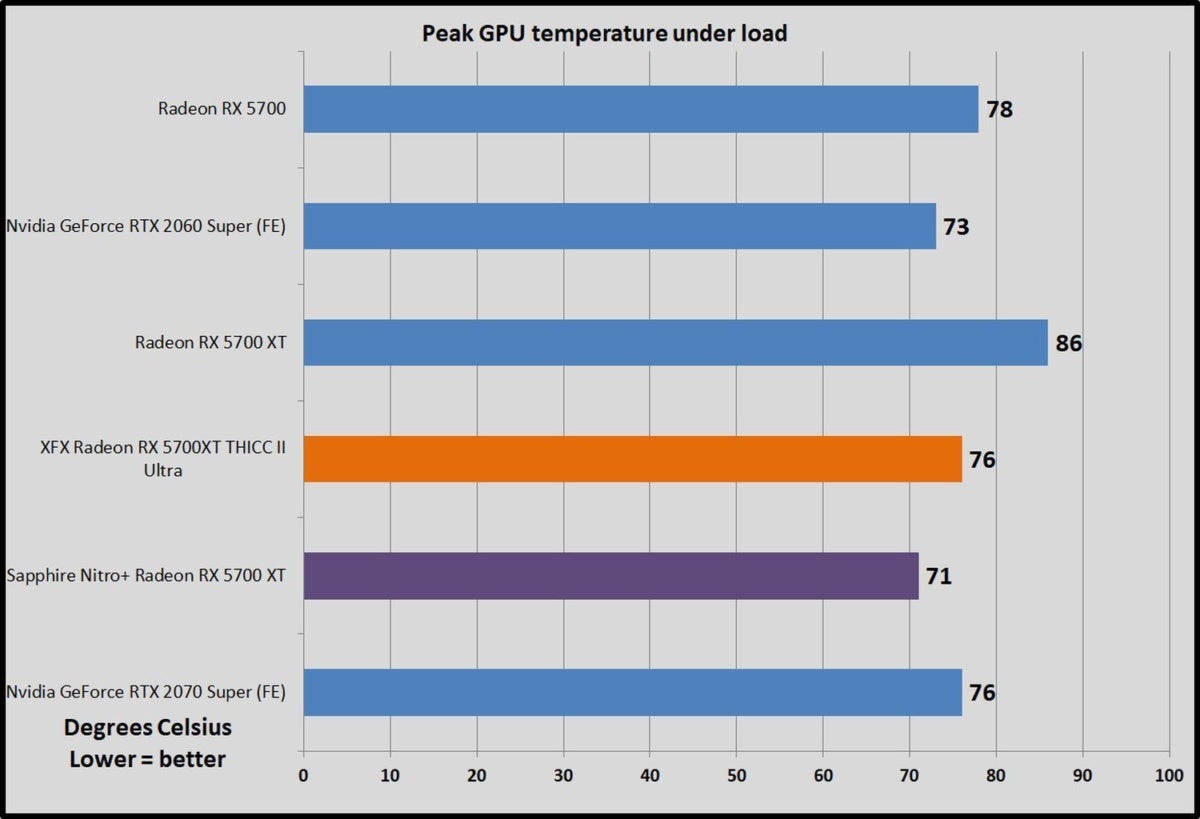 Brad Chacos/IDG
Brad Chacos/IDG The Sapphire Nitro+ is cold as a cucumber and quiet arsenic a mouse, even in its default overflowing-performance configuration. No complaints whatsoever. Sapphire's carte provides a very much better quality of life than the reference RX 5700 XT's hot, roaring blower-style cooler. The faster clock speeds sharpness the XFX Thicc II Ultra yet again, as IT runs hotter and louder in order to tame Navi at higher frequencies. Its dual fans spin 'tween 2,100rpm and 2,300rpm under shipment. The Nitro+'s trio of fans ne'er top 1,800rpm and still oversee to keep information technology 5 degrees ice chest. Sapphire found the sweet spot, it seems.
Next page: Should you grease one's palms the Sapphire Nitro+ Radeon RX 5700?
Should you buy the Sapphire Nitro+ Radeon RX 5700 XT?
Oh lord, yes.
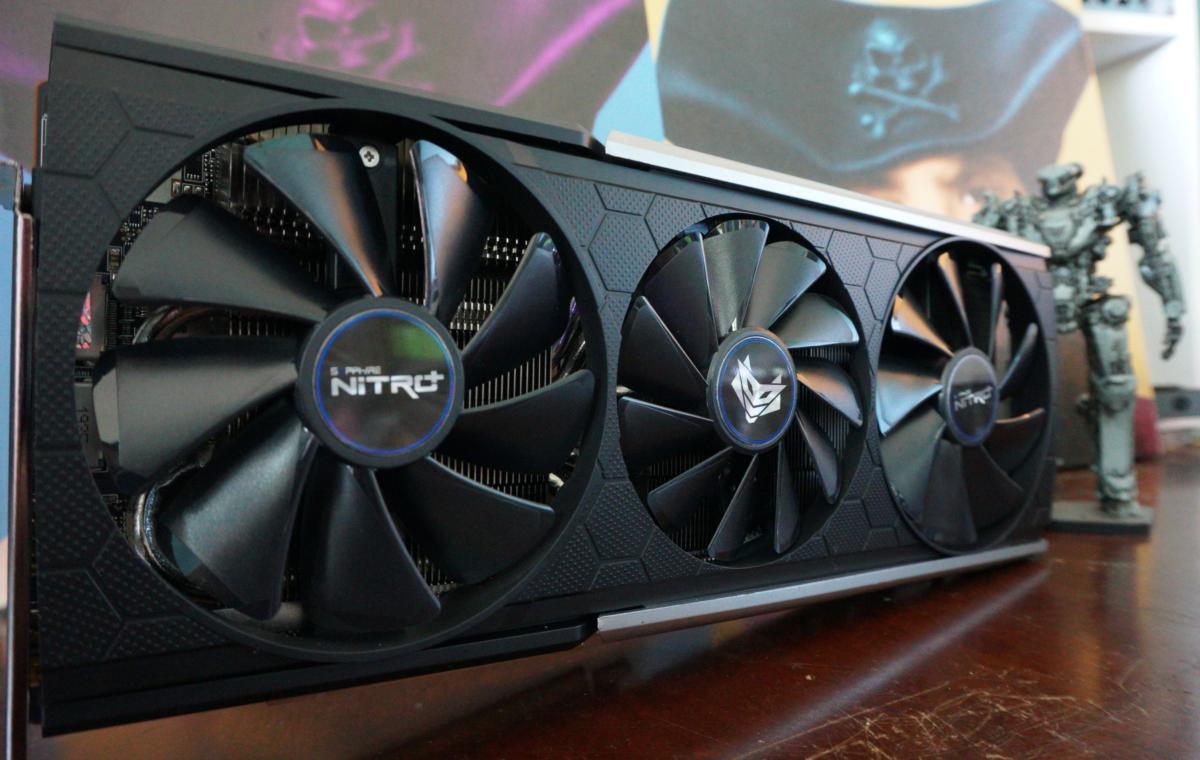 Brad Chacos/IDG
Brad Chacos/IDG The Radeon RX 5700 Crosstalk is a killer artwork card for 1440p gaming, and Sapphire's $440 overclocked Nitro+ delivers frame rates well on the far side likewise priced GeForce RTX 2060 Supers and within spit distance of the $500 GeForce RTX 2070 Tiptop Founders Edition. Activating the wonderful Trixx Boost feature in Sapphire's Trixx package sends frame rates skyrocketing to (operating theater ancient) even the $700 RTX 2080 Super's carrying into action levels with minimal optic touch on, for hundreds of dollars less. Trixx Boost can even turn away this into a surprisingly decent 4K gaming card.
Encourage is just part with of Sky-blue's superb new updated Trixx software, which likewise lets you match your card's lover wellness, overclock your graphics card, see your system configuration, and manage the gorgeous RGB LED implementation on the Nitro+.
If you really love flashy lights, you can grease one's palms an optional $30 set of ARGB fans for the Nitro+—though they'll be stale to date in a standard case, pointing down—or assign their control to your motherboard's software with the aid of a 3-trap RGB cope at the end of the placard. Sapphire likewise equipt the Nitro+ was a triple-BIOS switch loaded with two different fan profiles and the option to handle switching 'tween them in Trixx itself, negating the need to ever open your case.
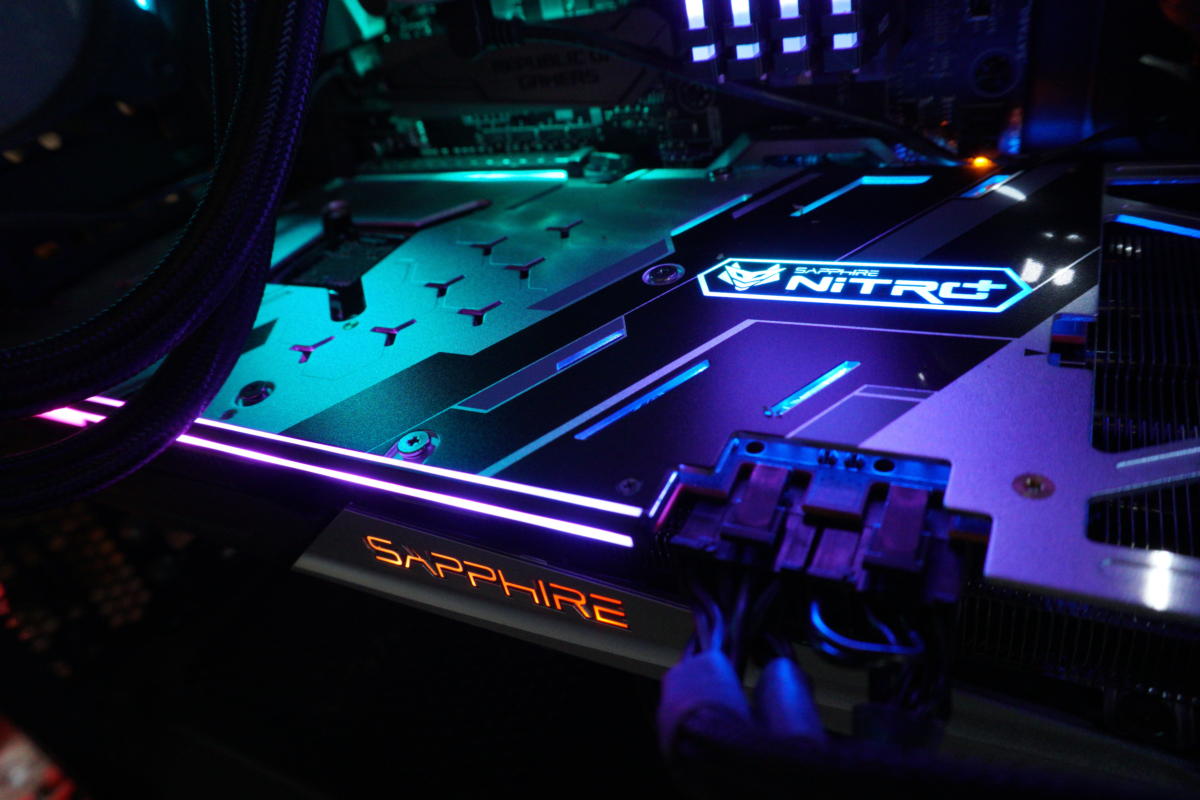 Brad Chacos/IDG
Brad Chacos/IDG The atomic number 13-clad Chromatic Nitro+ Radeon RX 5700 XT stays a cool 71 degrees Celsius even subordinate heavy loads, beating the match $440 XFX Thicc II Ultra by 5 degrees and dipping far below the reference RX 5700 Crosstalk's 86-degree temperatures. Better yet, it stays quiet throughout, with the fans never topping 1,800rpm.
Everything about this identity card feels perfectly well thought out, and it's near perfect as a result. The only possible drawbacks are out of Sapphire's control, and they aren't really drawbacks.
First, Radeon artwork cards don't support real-time ray tracing like GeForce RTX 20-serial publication GPUs offer—but in return, they offer you more traditional gaming performance for your money. The Nitro+ routinely outperforms the GeForce RTX 2060 away double-digit percentages. And while ray trace is picking up steam and looksunbelievably impressive in the right games, only a small handful of titles patronize the up-to-date lighting engineering at this point. Second, the Nitro+ is a big menu, mensuration a full foot long and a little terminated two slots deep. That's obligatory for a scorecard this effectual to work so cool and quiet though.
Fundament tune: I can't repute any single matter that Sky-blue could fare to make this calling card many lofty. The Sapphire Nitro+ Radeon RX 5700 XT is essentially perfect, incredibly powerful, and selfsame highly recommended. Azure's enhancements more justify the $40 price agio over the mention Radeon RX 5700 XT. If you use Trixx Boost to supercharge your anatomy rates with clever software tricks, you could even consider the Nitro+ one hell of a value. Assassin.
Note: When you purchase something after clicking links in our articles, we may earn a small delegation. Read our affiliate link insurance policy for Thomas More details.
Source: https://www.pcworld.com/article/398054/sapphire-nitro-radeon-rx-5700-xt-review.html
Posted by: byerlyellonly.blogspot.com


0 Response to "Sapphire Nitro+ Radeon RX 5700 XT review: Superfast and nearly flawless - byerlyellonly"
Post a Comment